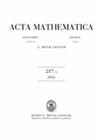Strassen直接和猜想的反例
IF 6.7
1区 数学
Q1 MATHEMATICS
引用次数: 26
摘要
双线性系统的乘法复杂度(特别是著名的矩阵快速乘法问题)是现代计算理论的一个重要研究领域。关于这个主题的基础论文之一是Strassen的工作[20],其中包含一个O(n7 / ln)算法用于两个n×n矩阵的乘法。Strassen在1973年发表的后续论文[21]中,提出了两个依赖于不同变量的双线性系统的并集的乘法复杂度是否等于两个系统的乘法复杂度之和的问题。Feig和Winograd在1981年的论文[10]中提出了这个问题的一个更强的版本,他们问是否任何计算这样一对双线性系统的最优算法必须分别计算每个系统。这些问题分别被称为直接和猜想和强直接和猜想,它们在四十年中吸引了大量的关注。正如Feig和Winograd所写,“直接和猜想的证明或反例将是我们理解双线性形式系统复杂性的重要一步。”这个猜想的现代表述是基于双线性系统作为三维张量的自然表示,也就是说,一个元素数组T (i|j|k)取自域F,其中三元组(i, j, k)运行于有限索引集i, j, k的笛卡尔积上。对于某些向量A∈FI, b∈FJ, c∈FK,如果T = A⊗b⊗c(应该读作T (i|j|k) = aibjk),张量T被称为可分解的。张量T的秩,或者对应双线性系统的乘法复杂度,是最小的r,其中T可以写成r个可分解张量的和,这些张量的项在F中。我们用rankF T表示这个量,并且我们注意到,如果允许从F的扩展中取上述可分解张量的项,那么张量的秩可能会改变,参见[3]。取两个依赖于不相交变量集的双线性系统的并,对应于张量的直接和运算。更准确地说,如果T和T '是具有不相交索引集I, I, J, J, K,K的张量,那么我们可以将T⊕T '定义为具有索引集I∪I, J∪J, K∪K '的张量,使得(I|J |K)块等于T, (I ' |J ' |K)块等于T,并且这些块之外的所有项都为零。换句话说,张量的直接和是块对角矩阵的多维模拟;线性代数的一个基本结论是这样的矩阵的秩等于它们对角线块的秩的和。Strassen的直接和猜想是这个陈述的三维模拟。本文章由计算机程序翻译,如有差异,请以英文原文为准。
Counterexamples to Strassen’s direct sum conjecture
The multiplicative complexity of systems of bilinear forms (and, in particular, the famous question of fast matrix multiplication) is an important area of research in modern theory of computation. One of the foundational papers on the topic is Strassen’s work [20], which contains an O(n 7/ ln ) algorithm for the multiplication of two n×n matrices. In his subsequent paper [21] published in 1973, Strassen asked whether the multiplicative complexity of the union of two bilinear systems depending on different variables is equal to the sum of the multiplicative complexities of both systems. A stronger version of this problem was proposed in the 1981 paper [10] by Feig and Winograd, who asked whether any optimal algorithm that computes such a pair of bilinear systems must compute each system separately. These questions became known as the direct sum conjecture and strong direct sum conjecture, respectively, and they were attracting a notable amount of attention during the four decades. As Feig and Winograd wrote, ‘either a proof of, or a counterexample to, the direct sum conjecture will be a major step forward in our understanding of complexity of systems of bilinear forms.’ The modern formulation of this conjecture is based on a natural representation of a bilinear system as a three-dimensional tensor, that is, an array of elements T (i|j|k) taken from a field F , where the triples (i, j, k) run over the Cartesian product of finite indexing sets I, J,K. A tensor T is called decomposable if T = a⊗b⊗c (which should be read as T (i|j|k) = aibjck), for some vectors a ∈ FI , b ∈ FJ , c ∈ FK . The rank of a tensor T , or the multiplicative complexity of the corresponding bilinear system, is the smallest r for which T can be written as a sum of r decomposable tensors with entries in F . We denote this quantity by rankF T , and we note that the rank of a tensor may change if one allows to take the entries of decomposable tensors as above from an extension of F , see [3]. Taking the union of two bilinear systems depending on disjoint sets of variables corresponds to the direct sum operation on tensors. More precisely, if T and T ′ are tensors with disjoint indexing sets I, I , J, J ,K,K , then we can define the direct sum T⊕T ′ as a tensor with indexing sets I ∪ I , J ∪ J , K ∪ K ′ such that the (I|J |K) block equals T and (I ′|J ′|K ) block equals T , and all entries outside of these blocks are zero. In other words, direct sums of tensors are a multidimensional analogue of block-diagonal matrices; a basic result of linear algebra says that the ranks of such matrices are equal to the sums of the ranks of their diagonal blocks. Strassen’s direct sum conjecture is a three-dimensional analogue of this statement.
求助全文
通过发布文献求助,成功后即可免费获取论文全文。
去求助
来源期刊

Acta Mathematica
数学-数学
CiteScore
6.00
自引率
2.70%
发文量
6
审稿时长
>12 weeks
期刊介绍:
Publishes original research papers of the highest quality in all fields of mathematics.
 求助内容:
求助内容: 应助结果提醒方式:
应助结果提醒方式:


